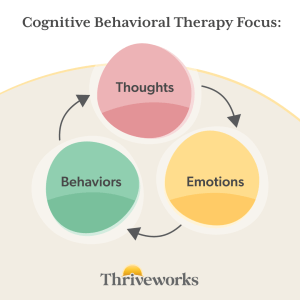Generally considered to be the gold standard of therapeutic counseling methods, cognitive behavioral therapy (CBT) aims to help clients cope with many of life’s hurdles by assessing the connection between thoughts, emotions, and behaviors. CBT is particularly well-known for offering clients coping strategies that work well outside of therapy.
CBT works primarily through a comprehensive (yet intuitive) process known as thought replacement. This involves the identification, evaluation, and replacement of negative thoughts—thoughts that produce unpleasant feelings or behaviors that may have ultimately driven the client to seek counseling in the first place.
Keep reading to learn more about this clinically proven therapeutic approach and how it can help you.
What Is Cognitive Behavioral Therapy (CBT)?
As stated above, cognitive behavioral therapy (CBT) is a type of therapy that looks at ways that your internal thinking patterns impact your beliefs about yourself, others, and the world as well as the ways that these thoughts influence your beliefs and behaviors. CBT is a collaborative process between the therapist and the client where the therapist employs various techniques to help the client recognize and reframe negative thought patterns.
Cognitive behavioral therapy works by bringing awareness to one’s internal processes and automatic thought patterns, giving them tools to evaluate the accuracy and helpfulness of these thoughts, and looking at the ways that these thoughts influence behaviors.
CBT is one of the most extensively researched and supported therapies for a range of psychological issues, including depression, anxiety disorders, substance abuse, and eating disorders. Its practical and directive approach allows clients to take an active role in their treatment, encouraging the development of self-help skills that can be used beyond therapy sessions.
By focusing on present issues rather than delving extensively into past experiences, CBT offers a pragmatic and forward-looking strategy for achieving mental wellness.
How Do You Explain CBT to Clients?
In practice, CBT is a structured, time-limited form of psychotherapy that helps you understand and change the thought patterns and behaviors that contribute to your emotional difficulties. In CBT, the client and therapist work together to identify negative or distorted thinking patterns that influence emotions and behaviors.
By challenging these thoughts and replacing them with more realistic and positive ones, clients can learn to cope more effectively with stress and reduce symptoms of anxiety, depression, and other issues.
Additionally, CBT involves practicing new skills and behaviors in real-life situations, not just in sessions, which can help foster healthier habits and responses. Through this process, CBT aims to empower clients to take control of their thoughts and actions, leading to lasting improvements in mental well-being.

How Does Cognitive Behavioral Therapy (CBT) Work?
The core premise of CBT is that our thoughts, feelings, and behaviors are interconnected and that changing negative thought patterns can lead to changes in feelings and behaviors. Therapists employ CBT to help people effectively manage their experiences, interactions, and inner dialogue as they face personal obstacles outside of therapy.
Common challenges that CBT can help with include:
- Dysfunctional relationships
- Family issues
- ADHD
- Depression
- Anxiety disorders
- PTSD
- Drug and alcohol abuse or addiction
- Eating disorders
CBT typically involves a structured process where the therapist and client work collaboratively to identify and challenge distorted cognitive patterns. Through regular practice and homework assignments, clients learn to apply cognitive and behavioral strategies in their daily lives. This active, problem-solving approach empowers clients to become their therapists, equipping them with the coping skills to manage future challenges independently.
In essence, it allows an individual to gain autonomy over their maladaptive thought patterns and cognitive distortions, reframing those thoughts into healthier, more realistic ones. Over time, this has a positive influence on thoughts and behaviors and increases self-efficacy.
What Is the Main Goal of CBT?
The primary goal of CBT is to provide clients with the tools they need to alter their behavior, decrease the frequency and impact of cognitive distortions, and replace these thoughts with more positive, helpful ones. Through CBT, clients can learn to:
- Identify harmful thoughts, cognitive distortions, and negative emotions when they arise
- Challenge the accuracy and usefulness of these negative headspaces
- Replace these negative feelings and thoughts with helpful, positive thought processes
- Put “therapy in motion” by practicing thought replacement in real-life situations
The foundation of CBT is built on the principle that we can be coached into identifying and eventually replacing negative or psychologically harmful thought and behavior patterns.
Who Can Benefit from CBT? Is Cognitive Behavioral Therapy (CBT) Right for You?
Cognitive behavioral therapy is beneficial for a wide range of individuals dealing with various mental health conditions and challenges. However, it may be most helpful to those who have specific problems they would like to address. Some of the specific issues that CBT can help clients manage include:
- Depression: People with depression can benefit significantly from CBT, as it aids in altering negative thought patterns and behaviors that contribute to their low mood. CBT works by targeting these negative patterns and introducing new coping strategies that help the individual deal with everyday challenges.
- Anxiety: CBT is particularly effective for those suffering from anxiety disorders, including generalized anxiety disorder, panic disorder, social anxiety disorder, and phobias, by helping them identify and challenge irrational fears and thoughts called “cognitive distortions.” CBT can remedy the effects of anxiety disorders by targeting negative anxious thoughts and teaching clients new, healthier patterns.
- Alcohol abuse and addiction: Alcohol abuse and addiction are tricky issues, as sufferers are at great risk of relapsing. CBT focuses on improving the client’s life in many ways in addition to just getting sober. This will further motivate them to stay away from the substance and lead a healthy, happy life.
Additionally, individuals experiencing stress, insomnia, and anger management issues can find CBT helpful in developing coping strategies and healthier behavioral responses.
Beyond specific mental health diagnoses, CBT is useful for anyone looking to improve their emotional regulation, problem-solving skills, and overall mental resilience. It is also beneficial for those dealing with life transitions, relationship problems, or chronic pain, offering tools to help them manage their thoughts and emotions more effectively. Overall, CBT’s structured, goal-oriented approach makes it a versatile and widely applicable form of therapy.
Hello, we're here to help you
We provide award-winning mental health services nationwide, with flexible scheduling & insurance coverage. Start your journey this week.
What Does a CBT Session Look Like?
In CBT sessions, a therapist will generally work with their client to first help them identify and understand their harmful attitudes and behaviors, which they may not be fully aware of.
As the therapeutic process progresses, clients will begin to adopt new and more effective ways of coping with situations and relationships outside of sessions. By the end of the therapy process, a client will hopefully have learned the coping skills needed to better manage their mental health conditions or other challenges. Sessions often average 50 minutes and may occur on a weekly or bi-weekly basis.
One distinguishing factor of CBT is that it’s typically a short-term commitment in comparison to other methods such as psychodynamic therapy. While everyone’s mental health needs are different, generally CBT may last up to five to 10 months, the point at which some clients’ emotional problems may begin to resolve or improve substantially, or they may feel equipped to handle them on their own.
What Are Cognitive Distortions?
Cognitive distortions are thoughts or thought patterns that are not true and/or helpful and negatively impact emotions, behaviors, and overall well-being. The thoughts themselves are not necessarily bad, but when they lead to unhelpful behaviors or hurtful emotions, they perpetuate a pattern that hurts us over time.
There are many types of cognitive distortions, including:
- Overgeneralization: This involves the belief that, since an event or situation happened once, it will happen every time. This can create a cycle of anxiety, causing individuals to jump to negative conclusions about experiences before the negative outcomes occur.
- Polarized thinking: This is “black and white thinking,” or thinking in extremes. A person, event, or situation is either horrible or fantastic — perfect or worthless.
- Filtering: This happens when we place a heavy focus on the negatives and ignore the positives.
- Blaming: Occurs when one places blame on themselves or others for every bad thing that happens.
- Catastrophizing: Also known as “magnifying or minimizing,” this cognitive distortion involves someone consistently expecting the worst.
- Emotional reasoning: A type of thinking in which one assumes their feelings must be true, despite a lack of facts or evidence.
- Control fallacies: This involves thinking where one’s life or behaviors feel either externally controlled (e.g., by fate or luck) or internally controlled (the individual is directly responsible).
- Fairness fallacy: In which a person measures every situation on a scale of fairness, which often leads to disappointment or objection.
- Personalization: In which individuals take everything personally; they assume that other people’s actions are direct reflections of others’ feelings toward them.
Correcting these cognitive distortions can help with day-to-day problem-solving. It is also an important part of CBT.
Techniques Used in Cognitive Behavioral Therapy
Some common techniques used in CBT include:
- Cognitive reframing: This involves identifying negative and distorted thoughts, challenging them, and replacing them with more balanced and accurate ones. Clients learn to question the evidence for their negative thoughts and develop more rational responses.
- Behavioral activation: This technique helps individuals engage in activities likely to improve mood and reduce depression. It involves planning and scheduling enjoyable or meaningful activities, even when they don’t feel like doing them.
- Exposure therapy: Used primarily for anxiety disorders, this technique involves gradual exposure to feared situations or objects, either in reality or imagination, to reduce fear and avoidance behaviors.
- Mindfulness and relaxation techniques: These include practices such as mindfulness meditation, deep breathing exercises, and progressive muscle relaxation to reduce stress and increase present-moment awareness.
- Activity scheduling: This involves creating a structured plan for activities throughout the day or week to encourage engaging in positive and productive behaviors.
- Problem-solving training: A systematic method for addressing and solving problems that contribute to stress or emotional difficulties. This can involve defining the problem, generating alternative solutions, evaluating and choosing the best solutions, and then implementing them.
- Cognitive behavioral techniques for insomnia (CBT-I): This includes methods specifically designed to improve sleep, such as sleep hygiene education, stimulus control therapy, sleep restriction therapy, and relaxation training.
- Thought records: This involves keeping detailed records of thoughts, emotions, and behaviors in specific situations. This helps in identifying patterns and provides material for cognitive restructuring.
- Role-playing: This technique has clients act out scenarios to practice and improve social skills, handle anxiety-provoking situations, or prepare for potential challenges.
- Skills training: This includes teaching specific skills that may be lacking, such as social skills, assertiveness, or anger management techniques.
- Imagery-based techniques: These involve using mental imagery to reduce anxiety, cope with traumatic memories, or envision positive outcomes.
- Journal or diary work: A therapist may assign his or her client the task of keeping a journal. The entries to come may reveal a vital part of the healing process for the client. Then, later in treatment, a therapist may assign other exercises or tasks related to coping and changing behavior based on insights gained from these entries.
CBT techniques help clients to recognize their irrational thinking and correct it. Over time, individuals will start to notice a pattern in their negative thinking on their own and reframe it to reflect reality instead of their false distortions.
How Effective is Cognitive Behavioral Therapy?
CBT’s efficacy for treating a wide variety of conditions and disorders is well-documented. For depression, CBT has been shown to be as effective as antidepressant medications, particularly for mild to moderate cases.
In treating anxiety disorders such as generalized anxiety disorder (GAD), social anxiety disorder, and panic disorder, CBT stands as the gold standard, employing techniques like exposure therapy and cognitive restructuring to manage and alleviate symptoms.
CBT also proves significantly beneficial for individuals with post-traumatic stress disorder (PTSD), using trauma-focused methods to process traumatic memories and reduce symptoms. For obsessive-compulsive disorder (OCD), CBT techniques like exposure and response prevention (ERP) are particularly effective in reducing obsessions and compulsions.
CBT has also shown success in treating substance use disorders by helping individuals recognize and avoid triggers and develop healthier coping strategies. It is even effective for managing chronic pain by altering perceptions and responses to pain.
CBT’s structured, time-limited, and goal-oriented approach equips individuals with practical tools to manage their symptoms and improve their overall quality of life.
How Can You Manage Anxiety with CBT? CBT for Anxiety Disorders
Cognitive behavioral therapy is a great tool for managing and effectively regulating anxiety by enabling someone’s baseline anxiety levels to be lowered. The 7 steps of CBT improve one’s ability to identify, challenge, and replace anxious thoughts that were previously sitting in the subconscious.
CBT allows individuals to remove their personal bias (their anxiety) and effectively regulate themselves, cultivating a response that is adaptive and grounded in the true reality of their situation.
How Can You Overcome Depression Through CBT? CBT for Depression
Similarly to the above, CBT helps allow an individual to overcome negative core beliefs about the self and negative automatic biases by empowering the client to identify and challenge maladaptive, false thoughts and beliefs about themselves and others. CBT allows them to overcome depression by sorting through thoughts that are grounded in fact vs. reality rather than thoughts that are rooted in false perceptions and self-deprecation.
CBT encourages people with depression to engage with automatic negative thoughts rather than to take them at face value.
What’s the Difference Between Dialectical Behavioral Therapy (DBT) and CBT?
Dialectical behavioral therapy (DBT) is a separate therapeutic method that employs certain CBT techniques to help clients experience personal growth. DBT is:
- The preferred treatment method for those with borderline personality disorder in particular
- Focused on distress tolerance, building a client’s resiliency to negative situations or difficult people
- Focused primarily on helping clients to talk through and process their issues, as opposed to adjusting their inner dialogue
DBT can be helpful both for those with borderline personality disorder and those who are experiencing interpersonal problems or more severe behavioral issues in certain environments.
Benefits of Cognitive Behavioral Therapy (CBT)
Cognitive behavioral therapy has many significant mental health benefits, most notably:
- Lowering levels of anxiety and depression
- Increasing self-confidence
- Increasing self-efficacy
- Increasing energy levels
- Increasing overall mood levels
- Decreasing overall stress levels
- Lowering blood pressure
- Decreasing anxious thought patterns
- Increasing levels of intrapersonal distress tolerance
CBT has also been shown to help increase the ability to have and maintain positive interpersonal relationships and may improve marriages, friendships, work life, and other relationships.
Finding Cognitive Behavioral Therapy at Thriveworks
If you’re interested in how CBT sessions at Thriveworks could help you regulate your negative thoughts and emotional patterns, don’t hesitate to start looking for a CBT-trained therapist who’s a great fit for you. You can easily find an experienced, licensed CBT therapist in your area in as little as a few minutes.
Don’t wait any longer; take the first step towards a brighter future. Schedule your CBT session with Thriveworks now.













